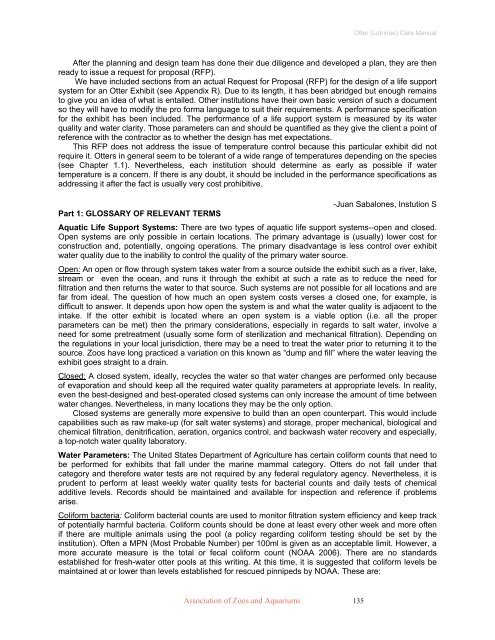Otter (Lutrinae) Care Manual - Association of Zoos and Aquariums
Otter (Lutrinae) Care Manual - Association of Zoos and Aquariums
Otter (Lutrinae) Care Manual - Association of Zoos and Aquariums
You also want an ePaper? Increase the reach of your titles
YUMPU automatically turns print PDFs into web optimized ePapers that Google loves.
<strong>Association</strong> <strong>of</strong> <strong>Zoos</strong> <strong>and</strong> <strong>Aquariums</strong> 135<br />
<strong>Otter</strong> (<strong>Lutrinae</strong>) <strong>Care</strong> <strong>Manual</strong><br />
After the planning <strong>and</strong> design team has done their due diligence <strong>and</strong> developed a plan, they are then<br />
ready to issue a request for proposal (RFP).<br />
We have included sections from an actual Request for Proposal (RFP) for the design <strong>of</strong> a life support<br />
system for an <strong>Otter</strong> Exhibit (see Appendix R). Due to its length, it has been abridged but enough remains<br />
to give you an idea <strong>of</strong> what is entailed. Other institutions have their own basic version <strong>of</strong> such a document<br />
so they will have to modify the pro forma language to suit their requirements. A performance specification<br />
for the exhibit has been included. The performance <strong>of</strong> a life support system is measured by its water<br />
quality <strong>and</strong> water clarity. Those parameters can <strong>and</strong> should be quantified as they give the client a point <strong>of</strong><br />
reference with the contractor as to whether the design has met expectations.<br />
This RFP does not address the issue <strong>of</strong> temperature control because this particular exhibit did not<br />
require it. <strong>Otter</strong>s in general seem to be tolerant <strong>of</strong> a wide range <strong>of</strong> temperatures depending on the species<br />
(see Chapter 1.1). Nevertheless, each institution should determine as early as possible if water<br />
temperature is a concern. If there is any doubt, it should be included in the performance specifications as<br />
addressing it after the fact is usually very cost prohibitive.<br />
Part 1: GLOSSARY OF RELEVANT TERMS<br />
-Juan Sabalones, Instution S<br />
Aquatic Life Support Systems: There are two types <strong>of</strong> aquatic life support systems--open <strong>and</strong> closed.<br />
Open systems are only possible in certain locations. The primary advantage is (usually) lower cost for<br />
construction <strong>and</strong>, potentially, ongoing operations. The primary disadvantage is less control over exhibit<br />
water quality due to the inability to control the quality <strong>of</strong> the primary water source.<br />
Open: An open or flow through system takes water from a source outside the exhibit such as a river, lake,<br />
stream or even the ocean, <strong>and</strong> runs it through the exhibit at such a rate as to reduce the need for<br />
filtration <strong>and</strong> then returns the water to that source. Such systems are not possible for all locations <strong>and</strong> are<br />
far from ideal. The question <strong>of</strong> how much an open system costs verses a closed one, for example, is<br />
difficult to answer. It depends upon how open the system is <strong>and</strong> what the water quality is adjacent to the<br />
intake. If the otter exhibit is located where an open system is a viable option (i.e. all the proper<br />
parameters can be met) then the primary considerations, especially in regards to salt water, involve a<br />
need for some pretreatment (usually some form <strong>of</strong> sterilization <strong>and</strong> mechanical filtration). Depending on<br />
the regulations in your local jurisdiction, there may be a need to treat the water prior to returning it to the<br />
source. <strong>Zoos</strong> have long practiced a variation on this known as “dump <strong>and</strong> fill” where the water leaving the<br />
exhibit goes straight to a drain.<br />
Closed: A closed system, ideally, recycles the water so that water changes are performed only because<br />
<strong>of</strong> evaporation <strong>and</strong> should keep all the required water quality parameters at appropriate levels. In reality,<br />
even the best-designed <strong>and</strong> best-operated closed systems can only increase the amount <strong>of</strong> time between<br />
water changes. Nevertheless, in many locations they may be the only option.<br />
Closed systems are generally more expensive to build than an open counterpart. This would include<br />
capabilities such as raw make-up (for salt water systems) <strong>and</strong> storage, proper mechanical, biological <strong>and</strong><br />
chemical filtration, denitrification, aeration, organics control, <strong>and</strong> backwash water recovery <strong>and</strong> especially,<br />
a top-notch water quality laboratory.<br />
Water Parameters: The United States Department <strong>of</strong> Agriculture has certain coliform counts that need to<br />
be performed for exhibits that fall under the marine mammal category. <strong>Otter</strong>s do not fall under that<br />
category <strong>and</strong> therefore water tests are not required by any federal regulatory agency. Nevertheless, it is<br />
prudent to perform at least weekly water quality tests for bacterial counts <strong>and</strong> daily tests <strong>of</strong> chemical<br />
additive levels. Records should be maintained <strong>and</strong> available for inspection <strong>and</strong> reference if problems<br />
arise.<br />
Coliform bacteria: Coliform bacterial counts are used to monitor filtration system efficiency <strong>and</strong> keep track<br />
<strong>of</strong> potentially harmful bacteria. Coliform counts should be done at least every other week <strong>and</strong> more <strong>of</strong>ten<br />
if there are multiple animals using the pool (a policy regarding coliform testing should be set by the<br />
institution). Often a MPN (Most Probable Number) per 100ml is given as an acceptable limit. However, a<br />
more accurate measure is the total or fecal coliform count (NOAA 2006). There are no st<strong>and</strong>ards<br />
established for fresh-water otter pools at this writing. At this time, it is suggested that coliform levels be<br />
maintained at or lower than levels established for rescued pinnipeds by NOAA. These are:









